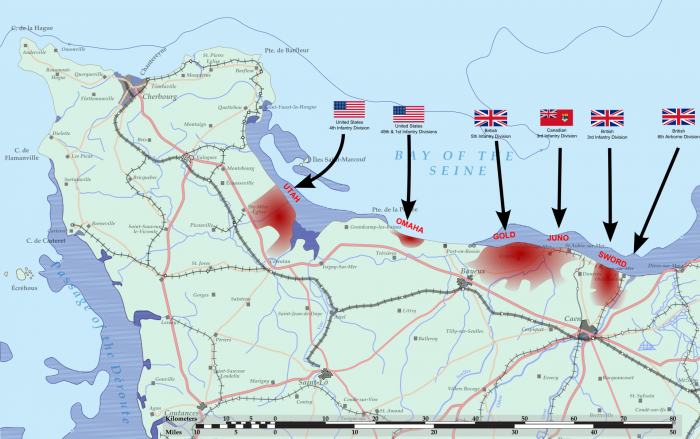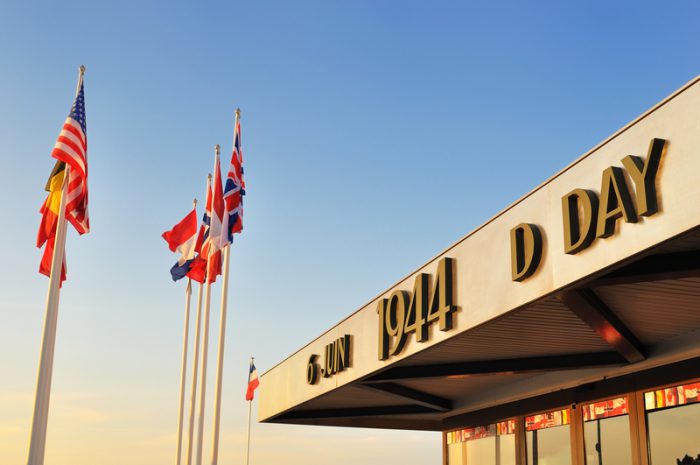Seventy-five years ago today, on June 6, 1944, a year's worth of Allied planning, preparation, training, and deception was all finally put into action.
The Allies — in particular British, American, and Canadian forces — landed on five beaches on the Normandy coastline in the north of France. This first day saw around 160,000 troops cross the English Channel. It is still the largest invasion of its kind in military history.
The reason for this mission, called Operation Neptune, was a simple one: to finally place an Allied force on the ground in Western Europe so that it could attack, and defeat, Nazi Germany.
Everything else about it was incredibly difficult.
Why was D-Day necessary?
Hitler tours Paris in June 1940 after his armies defeated the French. (Getty Embed)
During the first year of WWII, Nazi Germany used a new brand of warfare — blitzkrieg, or 'lightning war' — to quickly takeover a handful of European nations. Their swift tactics caught everyone by surprise, driving the Allies from the continent.
By June 25, 1940 — when France surrendered to Germany — every significant country in mainland Western and Central Europe was either occupied by Germany or was some sort of German ally. Only Britain, a island nation, stood opposed.
Over the next four years, Britain and its allies fought the Nazis. But generally, these battles always took place in the air or on the sea. Why? Because the Germans had near total control of Western European coasts and ports. How do you begin to start a ground war with an opponent if you can't even land an army there?
Plans and deception
British soldiers run a training exercise for a beach invasion. (Getty Embed)
Allied commanders knew that in order to defeat Hitler's forces, they would eventually have to return to France. In 1943, they began to make plans to do just that. How would they land? Where? How many troops would they need? What vehicles would they use? And when was the best time to do this? The preparation was enormous.
Maybe the biggest problem? The Germans also knew that the Allies eventually had to try to invade. And there were only so many places that they could do it, too. Look at this map.

Allied forces (in blue) had to cross the English Channel to reach northern France, where large German forces (in red) lay waiting. (Wikimedia Commons)
Seemingly everywhere that the Allies could land, the Germans would be waiting for them. How do you make an invasion of over 150,000 troops a surprise? To help get an edge, the Allied spent a year performing Operation Bodyguard.

Surprise! Inflatable tanks like this were used to fool German spy planes. (Wikimedia Commons)
This operation wasn't an invasion — it was a huge campaign of deception. They used fake transmissions and orders, actors pretending to be generals, and even hundreds of inflatable tanks in key areas. All of this and more was designed to confuse the Nazis.
The great landing
Allied forces landing at Omaha beach, June 6, 1944. (Getty Embed)
Eventually, all of the months of preparation ended. June 5, 1944 was selected for the landing. Then terrible weather conditions forced the Allies to push it back by a day to June 6. Even then, the weather was far from ideal, but the Allies couldn't wait any longer.

The five sectors, or beaches, where the Allies landed. (Wikimedia Commons)
They landed on five carefully selected sites, named Utah, Omaha, Gold, Juno, and Sword. The soldiers were carried and accompanied by over 5,000 sea craft. Hundreds of aircraft also participated, defending the landing troops and beating back Nazi aircraft.
All of the planning and deception worked. Though it would take several days, the Allies connected all five sites and landed their full army. From this position, they were eventually able to place over 875,000 troops on mainland Europe. And within a year, that army — along with the Russian army coming from the east — would arrive in Berlin, forcing the Nazi surrender.
The great sacrifice
At the site of Gold Beach, pieces of the temporary harbour, called Mulberry Harbour, still remain today. (Getty Embed)
Today, 75 years later, many nations are remembering this success. It completely changed the path of the war in Europe. Allied victory would not have happened without it.
But they are also remembering the incredible sacrifices that were made. Immediately upon landing on the beaches, soldiers encountered booby traps, fences, explosive mines, and intense enemy fire. On the first day alone, about 10,000 Allied soldiers were killed landing in Normandy.
Their sacrifices made one of the most impossible invasions in the history of the world possible.
 A D-Day Memorial in Normandy, France. (© Stockcube - Dreamstime.com)
A D-Day Memorial in Normandy, France. (© Stockcube - Dreamstime.com)










Truly…. a day to remember every day.